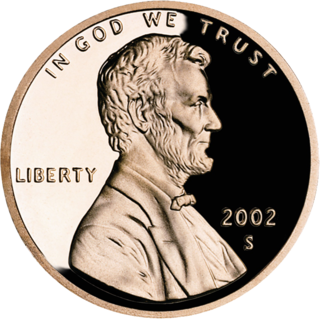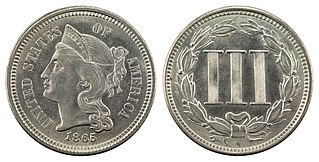Coins of the United States dollar - aside from those of the earlier Continental currency - were first minted in 1792. New coins have been produced annually and they comprise a significant aspect of the United States currency system. Circulating coins exist in denominations of 1¢, 5¢, 10¢, 25¢, 50¢, and $1.00. Also minted are bullion, including gold, silver and platinum, and commemorative coins. All of these are produced by the United States Mint. The coins are then sold to Federal Reserve Banks which in turn put coins into circulation and withdraw them as demanded by the United States economy.

The Canadian dollar is the currency of Canada. It is abbreviated with the dollar sign $. There is no standard disambiguating form, but the abbreviations Can$, CA$ and C$ are frequently used for distinction from other dollar-denominated currencies. It is divided into 100 cents (¢).

The cent, the United States of America one-cent coin, often called the "penny", is a unit of currency equaling one one-hundredth of a United States of America dollar. It has been the lowest face-value physical unit of U.S. currency since the abolition of the half-cent in 1857. The first U.S. cent was produced in 1787, and the cent has been issued primarily as a copper or copper-plated coin throughout its history. Due to inflation, pennies have lost virtually all their purchasing power and are often viewed as an expensive burden to businesses, banks, government and the public in general.
The Hong Kong dollar is the official currency of the Hong Kong Special Administrative Region. It is subdivided into 100 cents or 1000 mils. The Hong Kong Monetary Authority is the monetary authority of Hong Kong and the Hong Kong dollar.

A nickel is a five-cent coin struck by the United States Mint. Composed of cupronickel, the piece has been issued since 1866. Its diameter is 0.835 inches (21.21 mm) and its thickness is 0.077 inches (1.95 mm).

The franc, also commonly distinguished as the French franc (FF), was a currency of France. Between 1360 and 1641, it was the name of coins worth 1 livre tournois and it remained in common parlance as a term for this amount of money. It was reintroduced in 1795. After two centuries of inflation, it was redenominated in 1960, with each new franc (NF) being worth 100 old francs. The NF designation was continued for a few years before the currency returned to being simply the franc. Many French residents, though, continued to quote prices of especially expensive items in terms of the old franc, up to and even after the introduction of the euro in 2002. The French franc was a commonly held international reserve currency of reference in the 19th and 20th centuries. Between 1998 and 2002, the conversion of francs to euros was carried out at a rate of 6.55957 francs to 1 euro.

The lira or pound was the currency of Malta from 1972 until 31 December 2007. One lira was divided into 100 cents, each of 10 mils. After 1986 the lira was abbreviated as Lm, although the original £M sign continued to be used unofficially. In English the currency was still frequently called the pound even after its official English language name was changed to lira.

The Romanian leu is the currency of Romania. It is subdivided into 100 bani, a word that means both "money" and "coin" in the Romanian language.

The lira was the currency of Italy between 1861 and 2002. It was introduced by the Napoleonic Kingdom of Italy in 1807 at par with the French franc, and was subsequently adopted by the different states that would eventually form the Kingdom of Italy in 1861. It was subdivided into 100 centesimi, which means "hundredths" or "cents". The lira was also the currency of the Albanian Kingdom from 1941 to 1943.

The Jamaican dollar has been the currency of Jamaica since 1969. It is often abbreviated to J$, the J serving to distinguish it from other dollar-denominated currencies. It is divided into 100 cents, although cent denominations are no longer in use as of 2018. Goods and services may still be priced in cents, but cash transactions are now rounded to the nearest dollar.

The Belgian franc was the currency of the Kingdom of Belgium from 1832 until 2002 when the Euro was introduced. It was subdivided into 100 subunits, each known as a centiem in Dutch, centime in French or a Centime in German.
The coins of Canada are produced by the Royal Canadian Mint and denominated in Canadian dollars ($) and the subunit of dollars, cents (¢). An effigy of the reigning monarch always appears on the obverse of all coins. There are standard images which appear on the reverse, but there are also commemorative and numismatic issues with different images on the reverse.

A debate exists within the United States government and American society at large over whether the one-cent coin, the penny, should be eliminated as a unit of currency in the United States. The penny costs more to produce than the one cent it is worth, meaning the seigniorage is negative – the government loses money on every penny that is created. Several bills introduced in the U.S. Congress would have ceased production of pennies, but none have been approved. Such bills would leave the five-cent coin, or nickel, as the lowest-value coin minted in the United States.

A coin wrapper, sometimes known as a bank roll or roll, is a paper or plastic container for a number of coins. In the 19th century, coins were distributed in large cloth bags and coins were hand wrapped. Since the onset of the 20th century, coin wrapping machines have been in use. The earliest patent for a coin wrapping machine was in 1901. By 1910, automatic coin counting machines were in use, which could reject counterfeit coins, wrap coins, and crimp the coin wrapper ends.
Commemorative coins of Canada are coins issued by the Royal Canadian Mint to commemorate significant persons, special events, and anniversaries.

The Coinage Act of 1965, Pub. L.Tooltip Public Law 89–81, 79 Stat. 254, enacted July 23, 1965, eliminated silver from the circulating United States dime and quarter dollar coins. It also reduced the silver content of the half dollar from 90 percent to 40 percent; silver in the half dollar was subsequently eliminated by a 1970 law.
The coins of the New Zealand dollar are used for the smallest physical currency available in New Zealand. The current denominations are ten cents, twenty cents, fifty cents, one dollar and two dollars. The $1 and $2 coins are minted in a gold colour, the 20c and 50c coins are silver colour and the 10c coin is plated in copper.

Coin roll hunting is the hobby of searching and sorting coinage pulled from circulation for collectible coins. This is achieved through obtaining rolled coin, boxed coin, or bagged coin from banks and credit unions. A variant of this practice involves banknotes and is carried out in essentially the same fashion, normally to search for unusual serial numbers, star notes, and misprints.

The United States dollar is the official currency of the United States and several other countries. The Coinage Act of 1792 introduced the U.S. dollar at par with the Spanish silver dollar, divided it into 100 cents, and authorized the minting of coins denominated in dollars and cents. U.S. banknotes are issued in the form of Federal Reserve Notes, popularly called greenbacks due to their predominantly green color.

The copper-nickel three-cent piece, often called a three-cent nickel piece or three-cent nickel, was designed by US Mint Chief Engraver James B. Longacre and struck by the United States Bureau of the Mint from 1865 to 1889. It was initially popular, but its place in commerce was supplanted by the five-cent piece, or nickel.
















